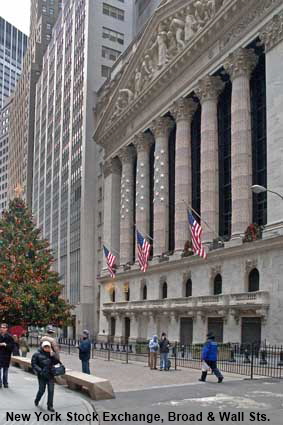This is where New York City began back in 1613 when Dutchman Adriaen Block founded a trading post at the southern tip of the island. In the 1620s families began to arrive to settle ‘New Netherlands’ so in 1626 the Dutch acquired Manhattan Island from the Lenape Indians and named the former trading post New Amsterdam. In 1664 it was conquered by the English who promptly renamed it New York. The Dutch retook the area in 1673 and renamed it New Orange, but ceded it permanently to England in 1674 so New York it became once again and has stayed ever since. The city that started at the southern tip has now grown to occupy the whole island and much more. As New York City spread out, Lower Manhattan became increasingly focused on the Financial Services industry based around Wall Street. On September 11, 2001 Lower Manhattan was the target for two of the four suicide attacks on the USA when hijacked Boeing 767 aircraft were flown into both towers of the World Trade Center. The impacts from the two aircraft and the subsequent collapse of both towers resulted in the deaths of 2,753 innocent people. A national memorial to all of the victims of the 9/11 terrorist attacks has been built on the footprints of the twin World Trade Center towers.
Fraunces Tavern, Pearl Street
Among the skyscrapers of Lower Manhattan there is still some history to be found. This house on Pearl Street was built in 1719 as the home of merchant Stephan Delancey. In 1762 it was purchased by Samuel Fraunces who converted it into a tavern. It was here in 1783, after the British left the USA, that George Washington bade farewell to his troops. From 1785 to 1790 New York was the capital of the USA and for a time the Departments of Foreign Affairs, War and the Treasury were based at the Tavern. Part of the building is still in operation as a restaurant while the rest of it is a museum. Click Tab 2 to see the interior of the museum.
Battery Park Firehouse & World Trade Center
The Firehouse at Battery Park had been decommissioned and converted into a restaurant when this picture was taken in 1990 but the World Trade Center (WTC) still stood proudly over it. Even though the Firehouse has been put to a new use it still serves as a reminder of the heroism shown by Firefighters following the attacks on September 11, 2001 and the terrible loss of life incurred when the WTC towers collapsed. Those towers each had 110 floors with Tower 2 on the right 417 metres (1368 feet) high and Tower 1 a couple of metres shorter. From 1973 to 1975 the WTC was the tallest building in the world. The view from the observation deck over Lower Manhattan and out to the Statue of Liberty was magnificent. Click Tab 2 to see the view of the East River, Manhattan and Brooklyn Bridges from the observation deck of the WTC, also taken in 1990.
New York Stock Exchange, Broad & Wall Streets
In 1644 the Dutch built a wall along the northern perimeter of their settlement to keep pirates and hostile Indians at bay. The wall was demolished in 1699 but the road alongside it remained and retained the name Wall Street. Nowadays it is renowned as the home of the New York Stock Exchange and is also home to many large Financial Institutions. The origin of the Stock Exchange was the 1792 Buttonwood Agreement signed by 24 New York City stockbrokers and merchants. The agreement committed them to trade only with each other, thereby creating the first organised market in New York. They initially met to trade under a Buttonwood Tree (hence the name of the agreement), but soon moved to a building in Wall Street. The current New York Stock Exchange building opened in 1865 and even though computers now do much of the work it remains the hub of the market.
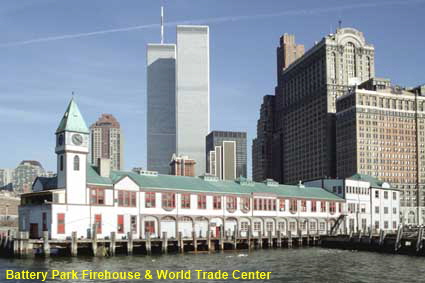
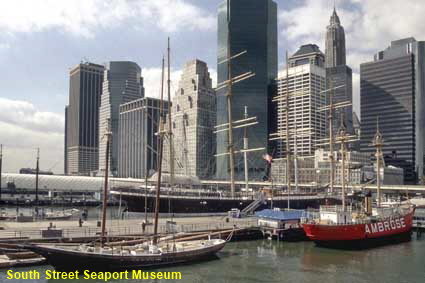
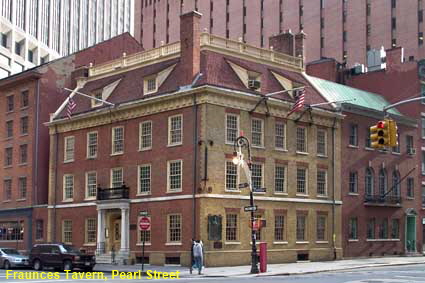
DLU170501
Interior of St Paul’s Chapel
Fraunces Tavern isn’t the only pre-revolutionary building to be found in Lower Manhattan. At the junction of Broadway and Fulton Street stands the oldest surviving church building in the whole of Manhattan. St. Paul’s Chapel was completed in 1766 on land granted by Queen Anne. It was designed by architect Thomas McBean, with master craftsman Andrew Gautier responsible for the construction work. During the Revolutionary War militia drilled in the churchyard and George Washington worshipped here on the day of his inauguration as President. In the 20th century the chapel became surrounded by tall skyscrapers, including at the western end of its graveyard, the World Trade Center. Despite being only a stones throw from 9/11 attacks, the chapel survived without serious damage and for 8 months after the attacks it became a sanctuary where recovery workers could get rest, food and support during their difficult work on the ruins of the WTC. Many of the banners from that time are still on show in the chapel. St. Paul’s Chapel remains a place of active worship but it is also a major tourist attraction.
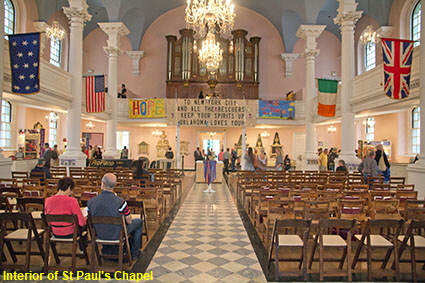
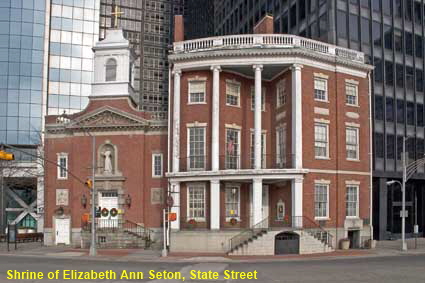
Click on Minimap to navigate
Shrine of Elizabeth Ann Seton, State Street
On State Street, dwarfed by the huge skyscrapers of Lower Manhattan you come across a church and a mansion. In the early 19th century the mansion was the home of Protestants William and Elizabeth Ann Seton. William went bankrupt in 1803 and was also very ill, so the Setons set sail for Italy to try to restore his health. William died in Italy and his widow returned to New York, but in Italy Elizabeth had discovered the Catholic faith and in 1805 she converted to Catholicism. She started the Catholic parochial school system in the USA and founded The American Sisters of Charity. She was canonised in 1975, thereby making her the first native-born American saint. Her former home on State Street is now the Shrine of Elizabeth Ann Seton.
South Street Seaport Museum
New York grew up as a seaport, but now most of the piers have been demolished or buried under landfill. Set up in 1967, the South Street Seaport Museum celebrates New York’s maritime history. As well as several galleries with changing exhibits, the museum has a number of historic vessels. In this picture the 1893 Schooner Lettie G Howard is berthed behind the 1908 lightship Ambrose. In the far side of the pier sits the much larger Peking, a four-masted barque launched in Hamburg in 1911. When you have had your fill of maritime history, you can indulge in some retail therapy at the adjacent Pier 17


To move forwards or backwards through the Manhattan trail click the arrows above, or select your next destination on the Minimap.
Lower Manhattan & Civic Center
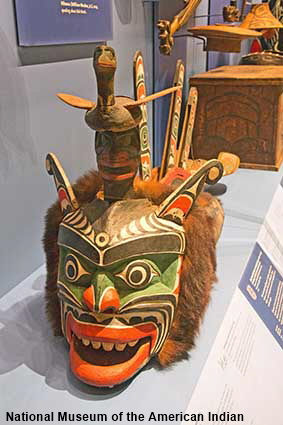
National Museum of the American Indian
The Alexander Hamilton U.S. Custom House was completed in 1907 to house officials responsible for collecting duty at the Port of New York. As New York was then a very busy port, the Custom House at 1 Bowling Green was a large and bustling place. In the early 1970’s the customs service was relocated to the ill fated World Trade Center, leaving the old Custom House under threat of demolition. Senator Daniel Patrick Moynihan saved the building from demolition in 1979 and work then started to renovate it. Two floors of the building are now the home of the New York branch of the National Museum of the American Indian. The museum has on display Indian artefacts and clothing from both North and South America. The picture shows a Kwakwaka Wakw Mechanical Mask from Vancouver Island in Canada dating back to around 1900. Entrance to the museum is free but in common with some other US Museums you have to pass through security that is more zealous than at an airport. In the centre of the Custom House is a rotunda that has on its ceiling murals painted in 1937 by New York painter Reginald Marsh. One series of murals depicts the early explorers of the Americas and anotherr shows the course of a ship entering New York harbour. The rotunda houses and exhibition on New York as a port. Click Tab 2 to see the rotunda and a few of the murals.
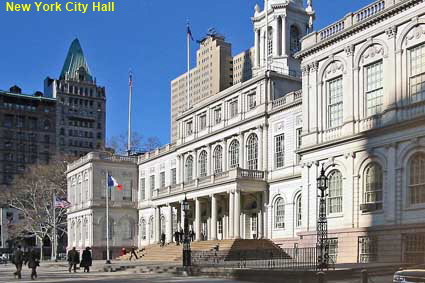
New York City Hall
New York’s third and current City Hall was built between 1803 and 1811 by Joseph Francois Mangin and John McComb Junior. It opened in 1812 as the official seat of the New York City government and the Mayor of the City. Mangin was a native of France and this was probably the origin of the French Renaissance style of the facade. The first City Hall was built by the Dutch settlers on Pearl Street. The second, built in 1700 at Wall and Nassau Streets, became Federal Hall when New York was capital of the USA and was demolished in 1812. The current Federal Hall in Wall Street was built in 1842 as a Customs House but gained its name when it was later used as a Federal store for gold & silver reserves.
National September 11 Memorial & Museum
Soon after the 2011 terrorist attacks on the World Trade Center, it was agreed that the footprints of the twin towers should become a memorial to the 2,977 victims and a museum should be built on the site to tell the story of this dreadful act. Israeli architect Michael Arad of Handel Architects designed two square pools at the base of the towers surrounded by a forest of trees. The names of every person who died in the 2001 attacks and and the six who died in the 1993 WTC bombing are inscribed into bronze panels edging the Memorial pools. The museum is underneath the memorial and there you can see the foundations of the twin towers plus exhibits from the wreckage including contorted girders plus some that miraculously survived. The museum follows the timeline of both the 1993 bombing and the 9/11 attacks, including some fairly graphic images of events. There is no charge to visit the memorial at the National September 11 Memorial & Museum, but there is a charge to visit the museum except on Tuesdays. Both are open daily. Click Tab 2 to see the remains of Fire Department Ladder Company 3 Truck. Ladder Company No 3 lost most of its men in the 9-11 attacks, the truck was parked on West Street and sustained serious damage during the collapse of the Twin Towers. Click Tab 3 to see a South Tower column folded in two during the collapse
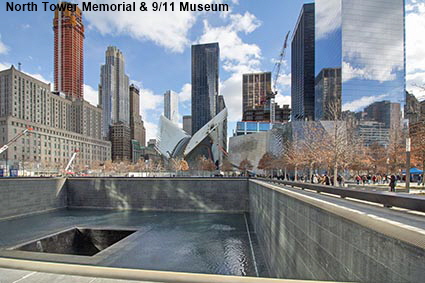
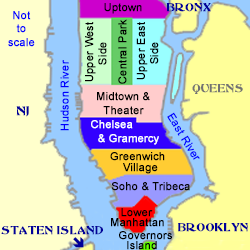

© Mike Elsden 1981 - 2025
The contents of this page may not be reproduced in full or in part without permission
